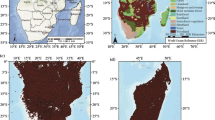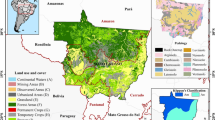Abstract
We evaluated the distribution, percentage, and homogeneous regions of fire foci in Brazil over 1998–2011. Included are numbers of fire foci by regions and states as well as their seasonal and monthly variations, with emphasis on human activities and their relationships with producing systems and rainfall inhibitors. We used data from forest fire meteorological satellites, obtained from the Centro de Previsão do Tempo e Estudos Climáticos. Evaluation of regional fire foci distributions gave 37.15 % for the central west and just 1.75 % in the south. Brazilian regions with the highest densities of forest fires per unit area were the northeast, central west, and north. Lowest densities were in the north, southeast, and south. The states of Mato Grosso, Pará, Maranhão, Bahia, Rondônia, and Tocantins had the greatest numbers of fire foci during our study period. The Federal District and the states of Sergipe, Espírito Santo, Rio de Janeiro, Rio Grande do Norte, and Alagoas had the smallest numbers. Spring (62.2 %) and winter (28.7 %) had higher frequencies than summer (6.7 %) and autumn (2.7 %). A clustering technique showed three homogeneous regions of fire foci in Brazil. The regional grouping technique showed the influence of synoptic systems and large-scale patterns of fires in the country. In addition to the use of NOAA-12 satellite images for monitoring Brazilian fire foci, orbital platforms such as MMODIS-01D and T-AQUA can be used. Finally, anthropogenic activities (deforestation, agriculture, livestock, mining, and industrial) and the variability of meteorological systems affected the fire increase during the study period.







Similar content being viewed by others
References
Alencar A, Nepstad D, Vera Diaz MC (2006) Forest understory fire in the Brazilian Amazon in ENSO and Non-ENSO years: area burned and committed carbon emissions. Earth Interact 10:1–17
Armenteras-Pascuala D, Retana-Alumbreros J, Molowny-Horas R, Roman-Cuesta RM, Gonzalez-Alonso F, Morales-Rivas M (2011) Characterising fire spatial pattern interactions with climate and vegetation in Colombia. Agric For Meteorol 151:279–289
Barros SS, Oyama MD (2010) Sistemas Meteorológicos Associados à Ocorrência de Precipitação no Centro de Lançamento de Alcântara. Revista Brasileira de Meteorologia 25:333–344
Bontempo GC, Lima GS, Ribeiro GA, Douglas SM, Silva E, Jacovine LAG (2011) Registro de ocorrência de incêndio (ROI): evolução, desafios e recomendações. Revista Biodiversidade Brasileira 1:247–263
Brown IF, Scroeder W, Setzer A, De Los Rios Maldonado M, Pantoja N, Duarte A, Marengo J (2006) Monitoring Fires in Southwestern Amazonia Rain Forests. EOS Trans Am Geophys Union 87:253–264
Campos CRJ, da Silva MV (2010) Impacto de Sistemas Meteorológicos no Regime Hídrico do Rio Grande do Sul em 2006. Revista Brasileira de Geofísica 28:121–136
Carvalho LMV, Jones C, Liebmann B (2004) The South Atlantic Convergence Zone: persistence, intensity, form, extreme precipitation and relationships with intraseasonal activity. J Clim 17:88–108
Chaves RR, Cavalcanti IFA (2001) Atmospheric circulation features associated with rainfall variability over southern Northeast Brazil. Mon Weather Rev 129:2614–2626
Chuvieco E, Opazo S, Sione W, Del Valle H, Anaya J, Di Bella C, Cruz I, Manzo L, Lopez G, Mari N, Gonzalez-Alonso F, Morelli F, Setzer A, Csiszar I, Kanpandegi JA, Bastarrika A, Libonati R (2008) Global burned-land estimation in Latin-America using MODIS composite data. Ecol Appl 18:64–79
Chuviesco E, Congalton RG (1989) Application of remote sensing and geographic information systems to forest fire hazard mapping. Remote Sens Environ 29:147–159
Correa CCG, Teodoro PE, Cunha ER, Oliveira-Júnior JF, Gois G, Bacani VM, Torres FE (2014) Spatial Interpolation of Annual Rainfall in the State Mato Grosso Do Sul (Brazil) Using Different Transitive Theoretical Mathematical Models. Int J Innov Res Sci Eng Technol 3:16618–16625
CPTEC—Centro de Previsão do Tempo e Estudos Climáticos (2012) BDQUEIMADAS. http://pirandira.cptec.inpe.br/queimadas/. Accessed 4 Feb 2012
Cui W, Perera AH (2008) What do we know about forest fire size distribution, and why is this knowledge useful for forest management? Int J Wildland Fire 17:234–244
Eva H, Fritz S (2003) Examining the potential of using remotely sensed fire data to predict areas of rapid forest change in South America. Appl Geogr 23:189–204
Evangelista H, Maldonado J, Godoi RMH, Pereira EB, Koch D, Tanizaki K, Fonseca R, Grieken V, Sampaio M, Setzer A, Alencar A, Gonçalves SC (2007) Sources and transport of Urban and biomass burning aerosol black carbon at the South-West Atlantic Coast. J Atmos Chem 56:225–238
Everitt BS, Dunn G (1991) Applied multivariate analysis. Edward Arnold, London, p 400
Ferraz SFB, Vettorazzi CA (1998) Mapeamento de risco de incêndios florestais por meio de sistema de informações geográficas (SIG). Sci For 53:39–48
França H, Setzer A (2001) AVHRR analysis of a savanna site through a fire season in Brazil. Int J Remote Sens 22:2449–2461
Giglio L, Descloitres J, Justice CO, Kaufman Y (2003) An enhanced contextual fire detection algorithm for MODIS. Remote Sens Environ 87:273–282
Gois G, Souza JL, Silva PRT, Oliveira-Júnior JF (2005) Caracterização da Desertificação no Estado de Alagoas Utilizando Variáveis Climáticas. Revista Brasileira de Meteorologia 20:301–314
Governo Federal (2012) Biomas Brasileiros. http://www.brasil.gov.br/sobre/meio-ambiente/geografia/tipos-de-clima. Accessed 2 Feb 2012
Graneman DC, Carneiro GL (2009) Monitoramento de focos de incêndio e áreas queimadas com a utilização de imagens de sensoriamento remoto. Revista de Engenharia e Tecnologia 1:55–62
Gutman G, Csiszar I, Romanov P (2000) Using NOAA/AVHRR products to monitor El niño impacts: forest on Indonesia in 1997–98. Bull Am Meteorol Soc 81:1189–1205
Hastenrath S, Heller L (1977) Dynamics of climatic hazards in north-east Brazil. Q J R Meteorol Soc 110:411–425
Hessl A, McKenzie D, Schellhaas R (2004) Drought and Pacific Decadal Oscillation linked to fire occurrence in the Inland Pacific North-west. Ecol Appl 14:425–442
Heyerdahl EK, McKenzie D, Daniels LD, Hessl AE, Littell JS, Mantua NJ (2008) Climate drivers of regionally synchronous fires in the inland Northwest (1651–1900). Int J Wildland Fire 17:40–49
IBGE—Instituto Brasileiro de Geografia e Estatística (2012) Área Territorial Oficial. http://www.ibge.gov.br/home/geociencias/cartografia/default_territ_area.shtm. Accessed 2 Feb 2012
Justice CO, Giglio L, Korontzi S, Owens J, Morisette JT, Roy D, Descloitres J, Alleaume S, Petitcolin F, Kaufman Y (2002) The MODIS fire products. Remote Sens Environ 83:244–262
Kayano MT, Kousky VE (1989) Southern hemisphere blocking: a comparison between to Indices. Meteorol Atmos Phys 42:165–170
Kidd C (2001) Satellite rainfall climatology: a review. Int J Climatol 21:1041–1066
Kousky VE, Gan MA (1981) Upper tropospheric cyclonic vortices in the tropical South Atlantic. Tellus 33:538–551
Libonati R, Dacamara CC, Pereira JMC, Peres LF (2010) Retrieving middle-infrared reflectance for burned area mapping in tropical environments using MODIS. Remote Sens Environ 114:831–843
Liebmann B, Kiladis GN, Marengo JA, Ambrizzi T, Glick JD (1999) Submonthly convective variability over South America and the South Atlantic convergence zone. J Clim 12:1877–1891
Lyra GB, Oliveira-Júnior JF, Zeri M (2014) Cluster analysis applied to the spatial and temporal variability of monthly rainfall in Alagoas state, Northeast of Brazil. Int J Climatol 34:3546–3558
Marengo J, Hasternrath S (1993) Cases studies climatic events in Amazon basin. J Clim 6:617–627
Marengo J, Liebmann B, Kousky V, Filizola N, Wainer I (2001) On the onset and end of the rainy season in the Brazilian Amazon Basin. J Clim 14:833–852
Margulis S (2003) Causas do desmatamento na Amazônia Brasileira, 1ª edn. Banco Mundial, Brasília, p 100
Marques RFC, Rao VB (2012) Interannual variations of blockings in the southern hemisphere and their energetics. J Geophys Res 105:4625–4636
Mendes MCD, Cavalcanti IFA, Trigo RM, Mendes D, Dacamara CC, Aragão MRS (2009) Episódios de Bloqueios no Hemisfério Sul: Comparação Entre Reanálises do NCEP/NCAR e Modelo HADCM3. Revista Brasileira de Meteorologia 24:262–275
Minuzzi RB, Sediyama GC, Barbosa EM, Melo Júnior JCF (2007) Climatologia do Comportamento do Período Chuvoso da Região Sudeste do Brasil. Revista Brasileira de Meteorologia 22:338–344
Molion LCB, Bernardo SO (2002) Uma Revisão da Dinâmica das Chuvas no Nordeste Brasileiro. Revista Brasileira de Meteorologia 17:1–10
Morisette JT, Giglio L, Csiszar I, Setzer A, Schroeder W, Morton D, Justice C (2005) Validation of MODIS active fire detection products derived from two algorithms. Earth Interact 9:1–25
Moura AD, Shukla J (1981) On the dynamics of droughts in northeast Brazil: Observations, theory and numerical experiments with a general circulation model. J Atmos Sci 38:2653–2675
Oliveira-Júnior JF, Delgado RC, Gois G, Lannes A, Dias FO, Souza JCS, Souza M (2014) Análise da Precipitação e sua Relação com Sistemas Meteorológicos em Seropédica, Rio de Janeiro. Floresta e Ambiente 21:140–149
Rao VB, Bonatti JP (1987) On the origin of upper tropospheric cyclonic vortices in the South Atlantic Ocean and adjoining Brazil during the summer. Meteorol Atmos Phys 37:11–16
Rao VB, Hada K (1990) Characteristics of Rainfall over Brazil: Annual Variations and Connections with the Southern Oscillations. Theor Appl Climatol 42:81–91
Rao VB, Lima M, Franchito SH (1993) Seasonal and interannual variations of rainfall over Eastern Northeast Brazil. J Clim 6:1754–1763
Reboita MS, Gan MA, Rocha RP, Ambrizzi T (2010) Regimes de Precipitação na América do Sul: Uma Revisão Bibliográfica. Revista Brasileira de Meteorologia 25:185–204
Santos DN, da Silva VPR, Sousa FAS, Silva RA (2010) Estudo de alguns cenários climáticos para o Nordeste do Brasil. Brasileira de Engenharia Agrícola e Ambiental 14:492–500
Silva de Souza L, Landau L, Moraes NO, Pimentel LCG (2012) Air quality photochemical study over Amazonia Area, Brazil. Int J Environ Pollut 48:194–202
Swetnam TW, Anderson RS (2008) Fire climatology in the western United States: introduction to special issue. Int J Wildland Fire 17:1–7
Trouet V, Taylor AH, Carleton AM, Skinner CN (2009) Interannual variations in fire weather, fire extent, and synoptic-scale circulation patterns in northern California and Oregon. Theor Appl Climatol 95:349–360
Ward JH (1963) Hierarchical grouping to optimize an objective function. J Am Stat Assoc 58:236–244
Zeri M, Oliveira-Júnior JF, Lyra GB (2011) Spatiotemporal analysis of particulate matter, sulfur dioxide and carbon monoxide concentrations over the city of Rio de Janeiro, Brazil. Meteorol Atmos Phys 113:139–152
Acknowledgments
The authors thank the Instituto Nacional de Pesquisas Espaciais/Centro de Previsão do Tempo e Estudos Climáticos for making available all data related to the forest fire meteorological satellites.
Author information
Authors and Affiliations
Corresponding authors
Rights and permissions
About this article
Cite this article
Caúla, R.H., Oliveira-Júnior, J.F., Lyra, G.B. et al. Overview of fire foci causes and locations in Brazil based on meteorological satellite data from 1998 to 2011. Environ Earth Sci 74, 1497–1508 (2015). https://doi.org/10.1007/s12665-015-4142-z
Received:
Accepted:
Published:
Issue Date:
DOI: https://doi.org/10.1007/s12665-015-4142-z




